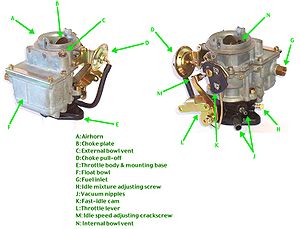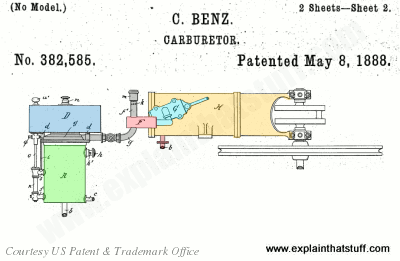A carburetor (American English) or carburettor(British English) is a device that mixes air and fuel for internal combustion engines in the proper air–fuel ratio for combustion. It is sometimes colloquially shortened to carb in the UK and North America or carby in Australia

Which engine uses carburetor?
Carburetor prepares a mixture of air and fuel (which is suitable for combustion) for an spark ignition engine. Carburetor is also used to control the speed of the vehicle. It converts petrol into fine droplets and mixes it in air in such away that it burns smoothly in engine, without any problem
Do any cars still use carburetors?
All production vehicles today use computerized fuel injection systems to feed fuel and air into the combustion chamber of the engine. ... After that, you have to let the engine warm up. Otherwise, it simply won't run right. Carburetors on cars operated the same way
What is a carburetor?
"The carburetor is called the 'Heart' of the automobile, and it cannot be expected that the engine will act right, give the proper horse-power, or run smoothly if its 'heart' is not performing its functions properly."
Gasoline engines are designed to take in exactly the right amount of air so the fuel burns properly, whether the engine is starting from cold or running hot at top speed. Getting the fuel-air mixture just right is the job of a clever mechanical gadget called a carburetor: a tube that allows air and fuel into the engine through valves, mixing them together in different amounts to suit a wide range of different driving condition
Who invented the carburetor?

Carburetors have been around since the late 19th century when they were first developed by automobile pioneer (and Mercedes founder) Karl Benz (1844–1929).
This diagram, which I've colored to make it easier to follow, shows the original Benz carburetor design from 1888; the basic working principle (explained in the box below) remains the same to this day.
In summary, then, here's how it all works:
- Air flows into the top of the carburetor from the car's air intake, passing through a filter that cleans it of debris.
- When the engine is first started, the choke (blue) can be set so it almost blocks the top of the pipe to reduce the amount of air coming in (increasing the fuel content of the mixture entering the cylinders).
- In the center of the tube, the air is forced through a narrow kink called a venturi. This makes it speed up and causes its pressure to drop.
- The drop in air pressure creates suction on the fuel pipe (right), drawing in fuel (orange).
- The throttle (green) is a valve that swivels to open or close the pipe. When the throttle is open, more air and fuel flows to the cylinders so the engine produces more power and the car goes faster.
- The mixture of air and fuel flows down into the cylinders.
- Fuel (orange) is supplied from a mini-fuel tank called the float-feed chamber.
- As the fuel level falls, a float in the chamber falls and opens a valve at the top.
- When the valve opens, more fuel flows in to replenish the chamber from the main gas tank. This makes the float rise and close the valve again.
No comments:
Post a Comment